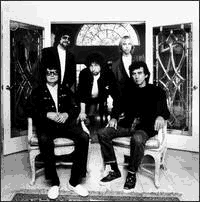AS THE DECADE TURNED, IT BECAME COMMON FOR TOP ACTS LIKE THE ROLLING STONES, JIMI HENDRIX AND THE DISINTEGRATING BEATLES TO ASSEMBLE FAMOUS CONFRERES IN THE SAME BOAT TO ADD ICING TO ALBUMS.
With his Traffic then on hold, Steve Winwood pontificated: "Today's scene is moving very much away from permanent groups. The trend is going more in the direction of the jazz scene when musicians just jam together as they please". In tacit endorsement in December 1968 came an ad hoc quartet of John Lennon, Eric Clapton, Keith Richards (on bass) and Hendrix's drummer on the hitherto unseen Rolling Stones Rock 'N' Roll Circus film.
Clapton had been invited to a less glamorous all-day function in a south-west London warehouse where many of the ablest musical technicians of two continents dissolved outlines between rock and jazz. Among those captured on film was drummer Buddy Miles whose Electric Flag colleague, guitarist Mike Bloomfield, had already been prime mover in a series of less erudite get-togethers in a US recording studio. With the likes of Buffalo Springfield guitarist Steve Stills and Blood Sweat and Tears organist Al Kooper, the edited result, modestly titled Super Session, was the best-selling CBS album of 1968.

The clouds parted again on the gods at play when producer Denny Cordell supervised the esteemed cast - including members of Procol Harum, Traffic and Led Zeppelin - who assisted on the debut album of Joe Cocker who had topped the UK chart with an aptly titled overhaul of the Beatles' 'With A Little Help From My Friends'. Further proof of the soundness of this strategy was when Screaming Lord Sutch also summoned renowned accompanists for two albums that each climbed into the US charts.
Sutch had been support act on the first UK tour by Cream who then removed themselves to grander showcases in North America where snow-blinded applause would greet "endless, meaningless solos", sighed Clapton. While stagnating artistically, Cream broke box office records with a farewell concert in 1968.
Clapton and Cream's drummer, Ginger Baker, next merged with Steve Winwood and bass guitarist Rick Grech for a more calculated "supergroup'. Called Blind Faith, they were the prototype of most supergroups since. Weeks before their debut performance in London's Hyde Park, a letter to Melody Maker wrongly fore-ordained "almost Beatle status" for them. Only a miracle could rescue them, even if the media build-up forestalled instant damnation after a disappointing but chart-topping album and a US tour during which audiences went as ape over strings of bum notes as the outfit's few startling moments.
Blind Faith's Precedent was followed more gainfully by Humble Pie - whose selling points were ex-Small Face Steve Marriott and former front man of the Herd, Peter Frampton - whose shallow mega-stardom accrued diminishing returns over 22 US tours. Next up was the "technoflash" pomp-rock of ELP - with former personnel from the Nice, King Crimson and Atomic Rooster - one of the most grandiloquent supergroups of all.
In a lighter vein, Steve Stills's extempore wanderings since Buffalo Springfield ended in a link-up with ex-Byrd Dave Crosby and Graham Nash, late of the Hollies, in the prosaically titled Crosby, Stills and Nash, styled a "supergroup" by the press before they'd sung a note in public. Predictably, they sold many millions of records.
After George Harrison's star-studded Concerts For Bangladesh extravaganza in Madison Square Garden, the supergroup idea was to wear thin later in the Seventies with such events as Eric Clapton's trumpeted come-back concert in 1974 at London's Rainbow Theatre with its noisy percussion artillery and glut of illustrious guitarists.
This most fascist of pop cliques reared up again in 1988 with the Traveling Wilburys - George Harrison, Roy Orbison, Bob Dylan, Jeff Lynne and Tom Petty. Their first effort, 'Handle With Care', could only have come from people who'd viewed the world from the cosseted Mount Olympus of stardom since the Sixties.
The chronicle would not be complete without mention of the "supersidemen" - an ebullient amalgam from Los Angeles' "blue-eyed soul school" - Carl Radle, Leon Russell, Bobby Keyes, Bobby Whitlock and so on. If was as if rock couldn't be done with any other people than these interchangeable session musicians. Some of them made boring albums of their own, the often short sides bloated with "laid-back" arrangements and lyrics that dwelt on "balling chicks", "toking", snorting cocaine and other overworked myths of the rock 'n' roll lifestyle. Underpinning them would be a snappy jitter described as "tight" or "funky". Exchanging smirks across the console, they and their hangers-on were the epitome of that smug, sexist elite of the early Seventies whose only contact with real life out in Dullsville was thought managers, runarounds and narcotics dealers.
